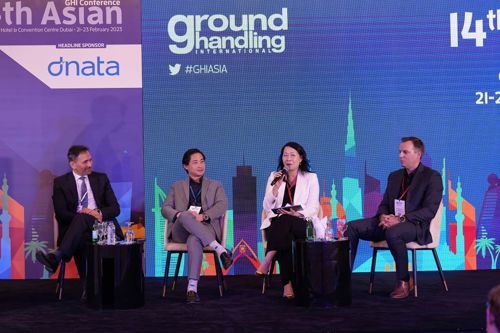
Asia was the first region of the world to be hit by the pandemic and the last one to reopen with China lifting the last of its restrictions.
Opening the show on Tuesday 21 February, Conference Chairman Max Gosney told the audience it had been 1,072 days since GHI was meant to host the 14th Asian Conference and it was great to be back.
The conference had already welcomed an ultra-VIP, His Highness Sheikh Ahmed bin Saeed Al Maktoum, who helped turn Dubai into the aviation hub that it is today and Emirates into a leading airline that many visitors had used to travel to the show.
In his opening speech, Gosney said: “When we were looking to locate this conference back in the dark days of the pandemic, late 2021, we were looking to find a destination that, we as conference organisers and you as delegates could believe in that it was possible to host an event and Dubai was very much open in the Covid period and it stood tall as a venue to facilitate and step up to the challenge of holding this Asian event.”
He wanted to thank dnata, the Emirates Group and the emirate of Dubai for their work in making the show possible. dnata was the headline sponsor so there was a round of applause for the whole team and the CEO, Steve Allen, who was present on the first panel discussion, before thanking all the sponsors for their support.
The conference started by looking at the rebound in demand Asia is experiencing now that restrictions have been lifted. Pre-pandemic, Asia was the fastest growing aviation market and it is working to retake the crown with markets such as Singapore and Hong Kong reopening last year and China opening its doors in January.
Citing a recent report from Avolon, Gosney said: “For every two seats of capacity being added by airlines globally, one is here in the Asian market. Traffic, according to IATA’s latest passenger data, is up over 300% and the Avolon report says that while the US and Europe were the growth leads when reopening in 2021 and 2022, the economies in the Asia-Pacific region look in the best place heading into 2023.”
The whiplash effect was a term from the report describing how rapidly demand rebounded with Gosney highlighting the need to recruit staff, which has always been a challenge, but it needs to be done on the double.
Brad Moore, Managing Director Asia and Australasia at Swissport called 2022 a tale of two halves, starting with opening domestic operations ramping up quickly before international borders opened up, which was in a staged fashion as different countries opened up. Things have accelerated with China opening up resulting in a surge of capacity, particularly to Japan and South Korea and also to Australia and New Zealand.
In Dubai, dnata ramped up early on, said Allen, working with the airport to make sure it was ready for services to resume, which was a success. Elsewhere in dnata’s network, Australia had a disorderly opening, Singapore was very organised and the Philippines was somewhere in between, which Allen said reflects the countries as much as it reflects the ground handling industry.

Innovation
Due to Asian markets reopening to passenger traffic, that was the major focus of the conference but there was time to talk cargo. The afternoon of day 2 had innovation sessions with Mohammed Akhlaq, Chief Commercial Officer of Unilode Aviation Solutions sharing the latest ULD innovations and Peter Hewett, Director Global Cargo, Security and Sustainable Ground Operations at Dronamics to share how drones can transform the industry.
Akhlaq, who joined Unilode late last year after a long and successful career in ground handling, most recently at dnata, gave a quick overview of the company, saying it had 160,000 ULDs, over 40 airline customers and over 50 certified repair centres. Unilode has tagged 120,000 of its ULDs, which will increase to 95% of the fleet by the end of the year, and it is investing heavily in its reader network.
Tracking assets with RFID has been possible since the 1970s, Akhlaq showed off the Sentinel 200 tag, which gives superior coverage so readers are not needed in every door as one reader can detect the asset from a distance.
People put tags in their baggage, leading Akhlaq to ask why, asking whether people do not trust airlines to provide information about the location of their bags. With its network of tags and readers, Unilode can provide this data for ULDs carrying both baggage and cargo.
He said, “We get this with Amazon and online shopping, we can see where our goods are but why is it that I don’t know where my bag is? The growth from an e-commerce and baggage point of view and IATA’s One Record for cargo will bring us closer to that.”
Hewett was next on stage to talk about how Dronamics, the world’s first drone airline with an AOC, will transform logistics. Dronamics’ model of serving the middle mile has the potential to reduce journey times by 80%, cut operating costs by 50% and lower CO2 emissions by up to 60% compared to traditional modes of transport. Its solution of cargo drones and a network of droneports can be integrated into supply chains. The drone has a payload of up to 350kg and a range of 2,500 kilometres, serving same-day shipping over long distances.
With only one aircraft, there is still a lot of research to do before these benefits can be realised, admitted Hewett, and producing something so innovative raises a lot of questions about safety which are still being tackled. Dronamics’ AOC is based in Malta and the team is working with IATA to write manuals for safe operations.
Hewett said, “As we start talking to people about this, it’s quite exciting because there is an endless amount of opportunities out there which we can aim for and improve on.”
Tracking recovery
With a fleet of 160,000 ULDs, Unilode Aviation Solutions can get interesting insights into market performance, according to Chief Operating Officer Babak Yazdani. Looking at the Middle East and West Asia exports, monthly movements fell sharply at the start of the pandemic and took until the start of 2022 to get near to pre-pandemic levels. The recovery continued throughout 2022 and movements were 2% above pre-pandemic levels by the start of 2023.
The rest of Asia Pacific has lagged behind due to strict Covid restrictions in several major markets such as Hong Kong and mainland China. For Asian exports, monthly movements are still down 34% and pre-pandemic levels and are expected to need anything between 11 and 18 months to recover. Load factors are recovering, a leading indicator that the market is returning to normal.
As a ULD service provider, Unilode interacts with ground handlers and freight forwarders on behalf of the airlines with account managers in all major hubs working with airline customers. Integrating customer information so it can offer end-to-end track-and-trace like the integrators do is something Unilode is working on.
Yazdani gave the audience the example of track-and-trace for an airline customer serving Alibaba from Hong Kong to Liege where Unilode has connected data to the ULD ID, something it wants to scale up.
“Bear in mind that air cargo is only 1% of global tonnage but represents over 30% of value, and the greatest driving that is e-commerce, which every three years is almost doubling. That ability to have end-to-end track-and-trace by air waybill integration is important and going to help us further enable the growth and the ease of working in e-commerce,” said Yazdani.

Strong growth expected
Guillaume Crozier, Senior Vice President Cargo, Airport Operations Division at dnata was next to give a presentation. Asia’s air cargo market is expected to grow 7.3% a year from $38.3 billion in 2022 to over $59 billion in 2028 with China, Australia, Japan, South Korea and India the dominant markets. In the Middle East and North Africa region, the market is expected to grow 6.7% a year from $17.7 billion to $27.8 billion driven by strong performances in Saudi Arabia, the UAE, Egypt, Morocco and Kuwait.
E-commerce is a major driver with the pandemic changing consumer behaviour as people shopped online and stopped going into shops. According to industry data, e-commerce passed the barrier of 20% of total retail sales in 2022 and will be almost 25% in 2025. The data forecasts retail e-commerce sales will be worth over $7 trillion, almost double 2020’s figure. Annual growth will slow from double-digit rates but will continue to post healthy results.
Crozier said, “Here in Dubai, we have developed our facilities with a new e-commerce facility with more space because we see the volumes growing and we have to manage our space accordingly. Terminal enhancements make sure that staff have a safe space to deliver the best service, we have put a lot of pride into making sure that the state-of-the-art facility has the staff experience to make people stay with us and enjoy working at dnata.”
Talking about technology dnata is working with IBS on a new Cargo Terminal Operation platform, with Crozier commenting, “We are launching the platform and we have put in a lot of effort over the last four years to make sure that the CTO platform matches everyone’s expectations, especially when it comes to data and process efficiency.”
Sustainability is key to every decision dnata takes, with Crozier saying it is not just a nice story, dnata is practising it every day with practical innovation such as electrifying its GSE fleets, recycling waste, making existing facilities more energy efficient and building new facilities to the highest standards.
Crozier gave one example, telling the audience, “Here in Dubai, we are recycling all the water from our air conditioning system to use throughout our facilities. We save 5,000 litres of water a day.”
Diversification
Countries across the ASEAN region are developing cargo hubs with significant investments being made in infrastructure, warehousing and technology, James Wong, Senior Vice President, South East Asia & China at Menzies Aviation told the audience.
The region represents over 30% of the global air cargo market with several booming countries and a strong demand for a variety of goods including pharmaceuticals and healthcare, perishables and e-commerce. Cargo capacity is being added in countries surrounding China, which Wong said is advantageous as China has traditionally been a hard market to enter for ground handlers. The development of cargo markets such as Vietnam, Cambodia, Malaysia and as far away as Indonesia provide entry points for China.
Wong said, “A key factor for all of these people is trying to create greater capacity in the constrained land that they have. That is quite advantageous for a ground handler as we assess these markets and determine whether or not they are feasible. As we jump from country to country, each one of them has their own strategic plan to become a cargo hub in the region.”
The biggest challenges in the ASEAN region are capacity constraints, labour shortages, environmental concerns, cost pressures, supply chain security and digitalisation.
Talking about capacity, Wong said, “We have visited quite a number of opportunities throughout the region and found that the available infrastructure is just not there. As a consequence of that, we are trying to find methods to increase throughput within the space.”
